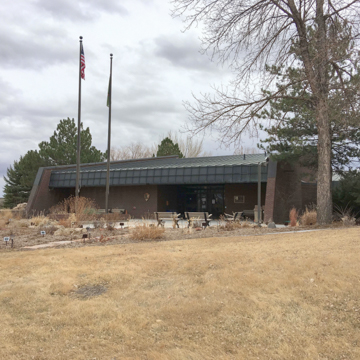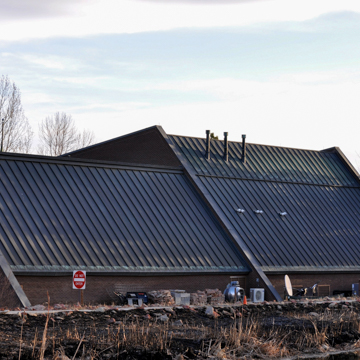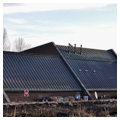You are here
Bighorn Canyon Visitor Center
The Bighorn Canyon Visitor Center is a National Park Service (NPS) building completed in 1976. Located in just east of Lovell, Wyoming, and west of Bighorn Canyon, it serves as a gateway to the Bighorn Canyon National Recreation Area, which covers more than 120,000 acres in Wyoming and Montana. The Visitor Center is located just off U.S. Highway 14A, and is accessed by foot from a parking lot north of the building.
The L-shaped Visitor Center is a notable example of solar architecture, recognized at the time as the first national park facility operated by solar energy. It represented “the desire on the part of the National Park Service to show the visiting public an example of new low energy use technology,” according to David Wright of the NPS. In historical terms, solar architecture reflected the global, political, and economic effects of the Oil Embargo of 1973 and President Nixon’s Project Independence.
The building incorporates exhibition space, a small theater, and bookstore within its 9,500 square feet. A solar energy exhibit was featured originally, but today exhibits focus on the geology and natural and cultural history of Bighorn Canyon and the surrounding areas. The structure represents a short-lived style of solar architecture from the 1970s, generally characterized by blunt, wedge-shaped forms, mass walls and floors, and south-facing windows and/or solar collectors. The entrance faces north, while the south elevation of the building is given over to the solar panels.
The Visitor Center was designed by Wirth Design Associates of Billings, Montana. The firm was led by Theodore J. “Ted” Wirth (1927–2009), whose father, Conrad “Conny” Wirth (1899–1993), served as the director of the NPS from 1951–1964, and his grandfather, Theodore Wirth (1863–1949), was superintendent of the Minneapolis Park System. Mechanical engineer and solar pioneer George Löf (1913–2009) designed the solar heating system, which consisted of flat-plate collectors (air heaters), fan-driven air circulation, and seventy-five tons of stones in the basement to store heat. The collectors were made by Solaron Corporation, which was founded by Löf; at the time, Solaron systems were known as “the Cadillac of the solar heating business.” According to Löf’s design, solar heating would provide 60-70 percent of the building’s heating needs. It was also designed to provide cooling in summer, by taking cool nighttime air and pushing it through the stone storage bed. The system never operated as intended and currently is not used.
In 2006 the building was dedicated to Cal S. Taggart (1924–2004), former Mayor of Lovell (1962–1968) and Wyoming State Senator (1972–1984). Taggart lobbied to create the facility and locate it in Lovell.
References
Denzer, Anthony. The Solar House: Pioneering Sustainable Design. New York: Rizzoli International Publications, 2013.
Shurcliff, William A. Solar Heated Buildings: A Brief Survey. 13th ed. Cambridge: W. A. Shurcliff, 1977.
Writing Credits
If SAH Archipedia has been useful to you, please consider supporting it.
SAH Archipedia tells the story of the United States through its buildings, landscapes, and cities. This freely available resource empowers the public with authoritative knowledge that deepens their understanding and appreciation of the built environment. But the Society of Architectural Historians, which created SAH Archipedia with University of Virginia Press, needs your support to maintain the high-caliber research, writing, photography, cartography, editing, design, and programming that make SAH Archipedia a trusted online resource available to all who value the history of place, heritage tourism, and learning.




